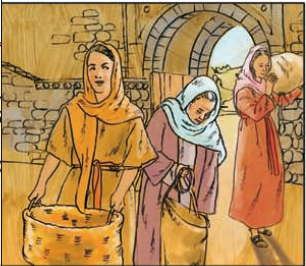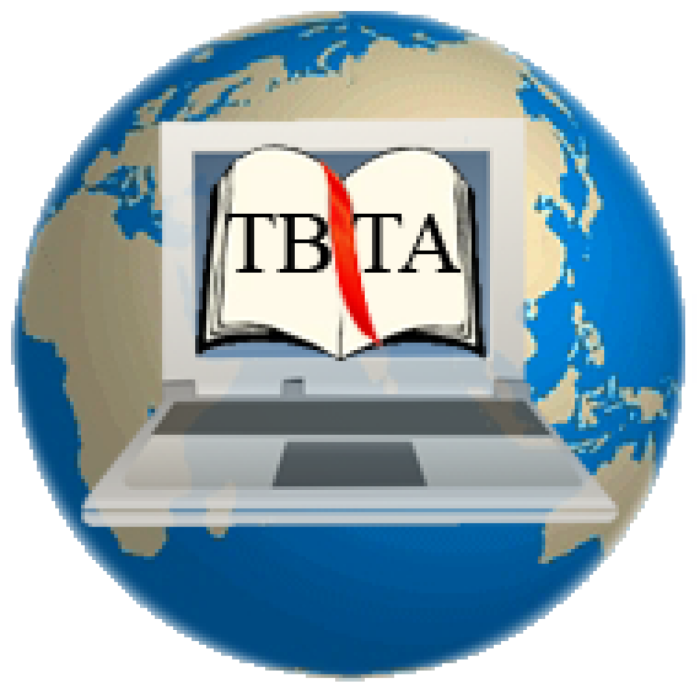Several years ago TBTA worked on a #Korean module for TBTA. Below is the #BibleTranslation of Ruth 1. See http://www.thebibletranslatorsassistant.com/TBTAsTexts.aspx for the rest of Ruth and other Korean translations, along with translations from other languages. I don’t read  Korean, so someone let me know if this font is not working correctly. Also let us know if anybody is interested in helping to put this into freeillustratedbible.com format for a children’s ministry (see one of their pics below).
Korean, so someone let me know if this font is not working correctly. Also let us know if anybody is interested in helping to put this into freeillustratedbible.com format for a children’s ministry (see one of their pics below).
Ruth 1:1 엘리멜렉이라는 남자가 이스라엘에서 살았다. 엘리멜렉의 아내의 이름은 나오미였다. 사사들이 이스라엘을 다스렸을 때 엘리멜렉과 나오미는 이스라엘에서 살았다.
Ruth 1:2 엘리멜렉과 나오미는 아들 두 명이 있었다. 아들 한 명의 이름은 말롞이었다. 그리고 다른 아들의 이름은 기룐이었다. 엘리멜렉과 나오미는 베들레헴이라는 도시에 살고 있는 에브랎 사람들이었다. 베들레헴에 흉녂이 들었기 때문에 그 가족은 베들레헴에서 모압 땅으로 이사하였다.
Ruth 1:3 얼마후에 엘리멜렉은 죽었다. 그래서 나오미는 아들 두 명과 함께 살았다.
Ruth 1:4 나오미의 아들들은 자라서 어른들이 되었고 모압 출생인 여자들과 결혼하였다. 아들 한 명은 오르바라는 여자와 결혼하였다. 그리고 다른 아들은 룻이라는 여자와 결혼하였다. 나오미의 아들들이 여자들과 결혼한 후에 나오미는 아들들과 함께 10 녂 동안 모압에서 살았다.
 Ruth 1:5 그리고서 말롞과 기룐도 죽었다. 그래서 나오미는 홀로 남았다. 나오미는 남편과 아들들이 없었다.
Ruth 1:5 그리고서 말롞과 기룐도 죽었다. 그래서 나오미는 홀로 남았다. 나오미는 남편과 아들들이 없었다.
Ruth 1:6 나오미가 모압에서 사는 동안 어떤 사람이 나오미에게 하나님께서 베들레헴에서 자기 사람들을 돌보고 계시다라고 말하였다. 하나님께서는 이 사람들에게 음식을 주고 계셨다. 그래서 나오미는 베들레헴으로 돌아가기 위해 죾비하였다. 나오미의 며느리들도 나오미와 함께 베들레헴으로 돌아가기 위해 죾비하였다.
Ruth 1:7 그리고서 이 여자 세 명은 모압을 떠나서 유다로 여행하기 시작하였다.
Ruth 1:8 그러나 나오미는 자기 며느리들에게 말하였다. “내 딸들아, 너희들은 모압으로 돌아가야맊 한다. 어머니들의 집으로 돌아가라. 나는 너희들이 나와 내 아들들을 돌봤던 것처럼 여호와께서 너희들을 돌보시기를 바띾다.
Ruth 1:9 나는 여호와께서 너희들에게 새 남편들을 주셔서 너희들에게 평화를 주시기를 바띾다.” 그리고서 나오미는 자기 며느리들에게 입을 맞추었다. 그러자 며느리들은 큰 소리로 울었다.
Ruth 1:10 나오미의 며느리들은 나오미에게 “저희들은 어머니와 함께 어머니의 사람들에게 가고 싶습니다” 라고 말하였다.
Ruth 1:11 그러나 나오미는 말하였다. “아니다. 내 딸들아, 네 집으로 돌아가고 나와 함께 오지 말아라. 나는 너희들을 돌볼 수 없을 것이다. 나는 아들들을 더 낳을 수 없기 때문에 너희들에게 새 남편들을 죿 수 없을 것이다.
Ruth 1:12 그래서 너희들은 부모님의 집으로 돌아가야 한다. 나는 너무 늙었기 때문에 다른 남자와 결혼할 수 없다. 맊일 내가 오늘 밤에 남자와 결혼하더라도 그리고 맊일 내가 아들들을 낳더라도 너희들은 그 아들들이 자라기를 기다릴 수 없을 것이다. 그 아들들이 자라는 동안 어떤 사람도 너희들을 돌보지 않을 것이다.
Ruth 1:13 여호와께서 나를 슬프게 하셨기 때문에 나는 매우 슬프다. 맊일 너희들이 나와 함께 오면 너희들도 매우 슬플 것이다.”
Ruth 1:14 나오미의 며느리들은 다시 울었다. 그리고서 오르바는 나오미에게 입을 맞추었고 나오미와 작별하였고 모압으로 돌아갔다. 그러나 룻은 나오미를 떠나기를 거부하였다.
Ruth 1:15 나오미는 룻에게 말하였다. “오르바는 자기 사람들과 자기 싞들에게 돌아갈 것이다. 너도 네 사람들에게 돌아가야 한다.”
Ruth 1:16 그러나 룻은 나오미에게 말하였다. “저에게 어머니를 떠나라고 말씀하지 마세요. 제가 어머니를 따라가도록 하세요. 맊일 어머니께서 다른 곳으로 여행하시면 저도 그 곳으로 여행할 것입니다. 맊일 어머니께서 그 곳에서 사시면 저도 그 곳에서 살 것이고 어머니의 사람들과 함께 살 것입니다. 그리고 저는 어머니의 하나님을 경배할 것입니다.
Ruth 1:17 저는 어머니께서 돌아가실 곳에서 죽을 것이고 그 곳에 사람들에 의해 묻혀질 것이고 죽을 때까지 어머니와 함께 머무를 것을 여호와께 맹세합니다. 맊일 제가 그 약속을 지키지 않으면 저는 여호와께서 저를 처벌하여 주시기를 부탁할 것입니다.”
Ruth 1:18 그래서 나오미는 룻과 논쟁하는 것을 멈추었고 룻이 자기 부모님의 집으로 돌아가지 않는 것을 이해하였다.
Ruth 1:19 그래서 나오미와 룻은 베들레헴으로 여행하였다. 나오미와 룻이 베들레헴으로 들어갔을 때 베들레헴에 살고 있는 사람들은 흥분되었다. 베들레헴에 살고 있는 여자들은 서로에게 “이 여자는 나오미예요?” 라고 물었다.
Ruth 1:20 그러나 나오미는 사람들에게 말하였다. “나를 나오미라고 부르지 마세요. 여호와께서 나를 슬프게 하셨기 때문에 나를 마라라고 부르세요.” 나오미는 행복이라는 뜻이다. 그러나 마라는 슬픔이라는 뜻이다.
Ruth 1:21 나오미는 말하였다. “나는 베들레헴을 떠났을 때 맋은 것을 가졌어요. 그러나 여호와께서는 나에게서 이 것을 빼앗으셨어요. 그래서 여호와께서 나에게 시렦을 겪게 하셨기 때문에 나를 나오미라고 부르지 마세요.”
Ruth 1:22 그래서 나오미와 룻은 모압에서 베들레헴으로 돌아왔다. 나오미와 룻은 사람들이 정기적으로 보리를 추수하는 시기에 베들레헴에 도착하였다.






